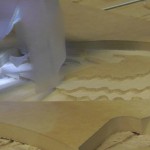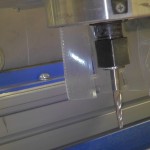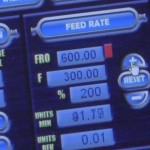3D Carving an Eagle – Rough Cut
 I recently designed a new Z axis for my CNC Router table which I named the Warp Drive Project. One of the members in a CNC Forum I belong to asked me how the Warp Drive would do with a 3D Carving project. The truth is I had never done a 3D project with the Warp Drive up till that point. I originally designed the Warp Drive Project to make cutting 3D projects faster but the Warp Drive worked so well I got busy making other projects instead. So I decided to take a file that folks were familiar with and try to cut it. I chose a free file that came with Vectric Aspire 3D CNC software. Vectric includes lots of free files with their software including a 3D Carving of an Eagle. If you haven’t tried Vectric products you don’t know what you are missing. The 3D Carving of an Eagle file is one of the many free tutorials included with the demo version of Aspire. The demo files that are included can be machined on your router table so that is an added bonus. I will show you how to get your free Demo copy of Vectric Aspire later in this post.
I recently designed a new Z axis for my CNC Router table which I named the Warp Drive Project. One of the members in a CNC Forum I belong to asked me how the Warp Drive would do with a 3D Carving project. The truth is I had never done a 3D project with the Warp Drive up till that point. I originally designed the Warp Drive Project to make cutting 3D projects faster but the Warp Drive worked so well I got busy making other projects instead. So I decided to take a file that folks were familiar with and try to cut it. I chose a free file that came with Vectric Aspire 3D CNC software. Vectric includes lots of free files with their software including a 3D Carving of an Eagle. If you haven’t tried Vectric products you don’t know what you are missing. The 3D Carving of an Eagle file is one of the many free tutorials included with the demo version of Aspire. The demo files that are included can be machined on your router table so that is an added bonus. I will show you how to get your free Demo copy of Vectric Aspire later in this post.
I Took a scrap piece of MDF (Medium Density Fiberboard) and decided to test with the roughing pass first. A roughing pass is when you take a deep cut from the workpiece to remove excess material quickly. I set my cutting speed at 300 Inches per minute and set the rapid movements to 750 IPM. These speeds were fast but not crazy. I wanted to sneak up on just how fast I could machine the part.
For the finishing pass I I set the initial cutting speed at 300 IPM. I experimented with the plunge rate and set it at 30 IPM and could go much higher. I set the rapid traverse settings at 750 IPM on all axis. I began cutting with these setting and the everything worked as planned. After the file had begun, I increased the feed rate in 10% increments all the way up to 600IPM with no problems or any noticeable change in cut quality. I watched the Feed rate indicator in Mach3. I noticed that there are many peaks and valleys in speed achieved. The lowest speed were in the 30 IPM range up through about 450 IPM while in the wider parts of the cut. I was really apprehensive about cutting this fast because I only had one finish bit. I used a 1/8″ tapered Ball nose bit from Think & Tinker for the finish pass and a 1/4″ downcut end mill for the final profile cut. I had the finish step over set at 20%, next time I will use a finer bit or a smaller step over. I hope that the results please everyone as much as they pleased me. There were some tooling marks which I plan to sand out with a Dremel Abrasive Brush sanders. MDF is not the greatest material to experiment with but I think the 3D Eagle came out good.
My conclusions from this experiment are that the majority of the speed and time savings come in the low detail areas of the cut. High detail areas are only moderately faster at my current setting. This can change by messing with acceleration and velocity in Mach3 to get the best results. I suspect a 3D carving setting could be determined and saved as a separate configuration in Mach3. That way you could use the special settings to reduce your machining times on 3D projects but still use your normal settings on 2D machining. I did some further testing and verified this theory. The acceleration setting have a huge impact on how fast the Z axis can move.
Bottom line: The answer to the question “Is the Warp drive capable of producing good quality 3D relief Carvings at 600 Inches Per Minute?”, is a resounding YES.
Here are the answers to some questions I was asked about the Warp Drive Project.
Q: Can the Warp Drive go faster than I tested?.
A: My belief is YES. When I get some inexpensive ball nose bits I will test higher speeds.
Q: Does the higher feed rate affect the cut time?
A: DEFINITELY. The higher feed rates allow faster CNC projects.
Q: Are plans Available?
A: Yes. Get Your plans here.





